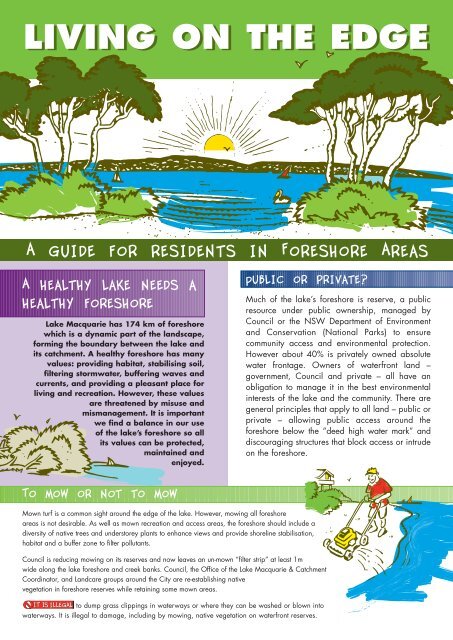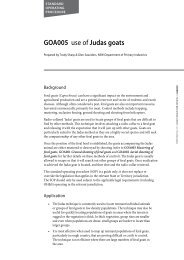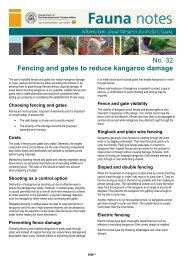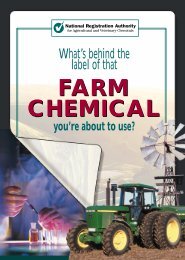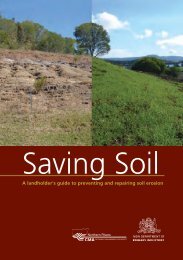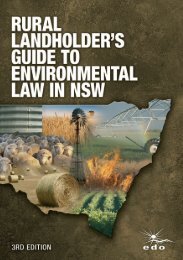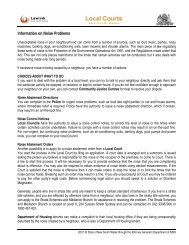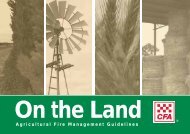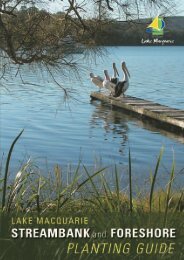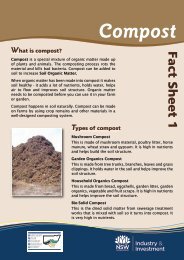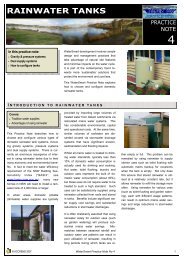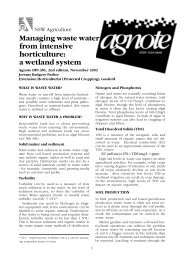EP 2148LIVING ON THE EDGE - Guide to Rural Residential Living
EP 2148LIVING ON THE EDGE - Guide to Rural Residential Living
EP 2148LIVING ON THE EDGE - Guide to Rural Residential Living
You also want an ePaper? Increase the reach of your titles
YUMPU automatically turns print PDFs into web optimized ePapers that Google loves.
LIVING <strong>ON</strong> <strong>THE</strong> <strong>EDGE</strong>A <strong>Guide</strong> for Residents in Foreshore AreasA healthy lake needs ahealthy foreshoreLake Macquarie has 174 km of foreshorewhich is a dynamic part of the landscape,forming the boundary between the lake andits catchment. A healthy foreshore has manyvalues: providing habitat, stabilising soil,filtering s<strong>to</strong>rmwater, buffering waves andcurrents, and providing a pleasant place forliving and recreation. However, these valuesare threatened by misuse andmismanagement. It is importantwe find a balance in our useof the lake’s foreshore so allits values can be protected,maintained andenjoyed.Public or private?Much of the lake’s foreshore is reserve, a publicresource under public ownership, managed byCouncil or the NSW Department of Environmentand Conservation (National Parks) <strong>to</strong> ensurecommunity access and environmental protection.However about 40% is privately owned absolutewater frontage. Owners of waterfront land –government, Council and private – all have anobligation <strong>to</strong> manage it in the best environmentalinterests of the lake and the community. There aregeneral principles that apply <strong>to</strong> all land – public orprivate – allowing public access around theforeshore below the “deed high water mark” anddiscouraging structures that block access or intrudeon the foreshore.To mow or not <strong>to</strong> mowMown turf is a common sight around the edge of the lake. However, mowing all foreshoreareas is not desirable. As well as mown recreation and access areas, the foreshore should include adiversity of native trees and unders<strong>to</strong>rey plants <strong>to</strong> enhance views and provide shoreline stabilisation,habitat and a buffer zone <strong>to</strong> filter pollutants.Council is reducing mowing on its reserves and now leaves an un-mown “filter strip” at least 1mwide along the lake foreshore and creek banks. Council, the Office of the Lake Macquarie & CatchmentCoordina<strong>to</strong>r, and Landcare groups around the City are re-establishing nativevegetation in foreshore reserves while retaining some mown areas.<strong>to</strong> dump grass clippings in waterways or where they can be washed or blown in<strong>to</strong>waterways. It is illegal <strong>to</strong> damage, including by mowing, native vegetation on waterfront reserves.
Disappearing treesIs your view really worth it? Damaging or removing nativeforeshore vegetation can result in the loss of a lot more thantrees (not <strong>to</strong> mention the fines you could incur). Nativevegetation stabilises the shoreline, provides a valuablehabitat for wildlife, provides shade, acts as a windbreak, iseffective in reducing glare from the water, and enhancesoverall views of the lake. The lake has already lost over 75%of its natural foreshore vegetation, so please help <strong>to</strong> conservewhat’s left.<strong>to</strong> damage or remove any vegetation onCouncil reserves. It is illegal <strong>to</strong> damage or remove any nativetrees or shrubs more than 3 metres tall on any land withoutCouncil consent.Let’s keep it cleanForeshore reserves are popular areas for fishing, walkingand picnicking. These activities are encouraged, howeverpeople sometimes leave bait bags, fishing tackle and otherlitter behind. Discarded tackle and fishing line can entanglewildlife and plastic bait bags can end up in the lake andcause death <strong>to</strong> animals such as dolphins and turtles whomistake plastic bags for jellyfish or squid.The relative isolation of some foreshore reserves canencourage the dumping of household and industrialrubbish. Apart from being unsightly, such rubbish maydestroy vegetation, encourage vermin, pose a safety risk(from broken glass, for example) or cause pollution.<strong>to</strong> litter or dump rubbish within a foreshorereserve, or anywhere else for that matter. A NSWrecreational fishing licence is generally required <strong>to</strong> fish infresh and salt water in NSW unless you are under 18.To report damaging and activities onforeshore reserves ring the Council Rangers on4921 0799 or 4921 0302.Further InformationLake Macquarie Streambank & Foreshore Planting<strong>Guide</strong> is available free from Council. It can also bedownloaded from Council’s website. The booklet providesguidelines for assessment & rehabilitation of lake foreshore andstreambank areas and a list of suitable plant species withinformation on where and how <strong>to</strong> plant them.Lake Macquarie Coastal Planting <strong>Guide</strong> is a valuablereference for individuals, Landcare, community, andenvironmental groups. It enables them <strong>to</strong> identify plant speciesindigenous <strong>to</strong> the Lake Macquarie coastal area, and sets outpractical rehabilitation and planting hints. The guide isavailable free from Council or can be downloaded fromCouncil’s website.<strong>EP</strong> 2148 04/05Some things you can do <strong>to</strong>be a foreshore friendLeave at least a 1 metre buffer along the edge ofthe foreshore and waterways when mowingPlant local native species in your waterfront bufferand garden and avoid plants that can “escape”in<strong>to</strong> bushlandRes<strong>to</strong>re a natural slope <strong>to</strong> your water frontage andensure access around the foreshoreHelp protect and rehabilitate foreshore bushlandby getting involved in LandcareLeave dead and fallen trees <strong>to</strong> provide wildlifehabitatCompost your grass clippings and garden wasteand keep it away from foreshore reservesS<strong>to</strong>re all privately owned equipment and materialswithin your property boundaryLaunch boats only from properly constructed andauthorised boat ramps and s<strong>to</strong>re boats withinyour propertyLeave dead seagrass along the foreshore beach <strong>to</strong>reduce erosion and provide habitatKeep vehicles off foreshore reserves <strong>to</strong> avoidenvironmental damageRemoveunauthorisedstructures, andensureauthorisedstructures aredesigned andmaintained <strong>to</strong> reduceenvironmental impactsTo obtain a copy of the guides, more copies of thisbrochure, or for further information on how youcan help <strong>to</strong> protect our foreshore contactLake Macquarie City Council4921 0333 or www.lakemac.com.auTo become involved in Landcare and foradvice on native plants and vegetationcontact Lake Macquarie Landcare Resource Office4959 5080 or email lro@kooee.com.auFor information and student guide on issues regardingmanaging the Lake and catchment visit thewebsite of the Office of the Lake Macquarie &Catchment Coordina<strong>to</strong>r www.livinglakemacquarie.orgProduced by Lake Macquarie City Council with fundingprovided by the Department of Infrastructure,Planning and Natural Resources
Community Land - are youa good neighbour?Many foreshore reserves lie between residences and the lake.Extending your ‘backyard’ in<strong>to</strong> the reserve can impact on thesensitive foreshore environment as well as the amenity of thereserve. All members of the public have a right <strong>to</strong> access and enjoyall areas of the reserve. Please treat foreshore reserves as youwould other neighbouring properties.The following activities are not environmentallyfriendly or neighbourly practices:Planting non-native garden plants on reserves – they can becomeweeds and spread in<strong>to</strong> natural bushland. They also change thenatural character which gives Lake Macquarie its identityDumping grass clippings, tree prunings or other garden wasteon reserves, which can also be a source of weedsBuilding fences, barbecues, sheds and other structures ands<strong>to</strong>ring privately owned items and materials on reservesCouncil encourages residents <strong>to</strong> help maintain and protectreserves by removing weeds and rubbish and regenerating nativebushland, but advice and permission is required before you carryout any activities (see “Further Information”).The s<strong>to</strong>rage of privately owned items on reserves can expose theirowner <strong>to</strong> legal liability should an accident or injury occur as aresult of their presence.<strong>to</strong> restrict access <strong>to</strong> foreshore reserves by structuressuch as fences or walls, or by landscape barriers such as garden bedsand hedges. Items and equipment illegally s<strong>to</strong>red on reserves can beordered by Council <strong>to</strong> be removed. Structures on private waterfrontland are generally not allowed in the “Lakefront Development Area”which is typically 6 metres landward from high water.Scooping the poopYou can take dogs on<strong>to</strong> Council reserves provided they are on aleash. There are also nearly 30 “leash free” areas, and these areclearly signposted. You cannot take your dog within 10 metres ofa play area or picnic area, or in<strong>to</strong> any Nature Reserves,Conservation Areas (such as Pulbah Island or Wangi Point) orNational Parks. And don’t forget <strong>to</strong> scoop your dog’s poop!<strong>to</strong> allow your dog in<strong>to</strong> protected reserves suchas State Conservation Areas, or <strong>to</strong> allow them off-leash except ina designated “off-leash” area. It is illegal <strong>to</strong> allow your dog <strong>to</strong> foulwaterways and public areas.The Great WallMany residents with absolute water frontage seek <strong>to</strong> protecttheir land against erosion by constructing seawalls.Seawalls are not the best option for protecting the shoreline forseveral reasons:They interrupt natural wave and tidal movement. This preventsseagrass from washing on<strong>to</strong> the shore and drying out.Instead, it accumulates and decomposes in the water, creatingwater quality and odour problems including the familiar“black ooze” (caused by rotted organic material). As a result,aquatic animal life is also reducedThey result in the transfer of wave energy along the shorelineand beyond the wall, increasing erosion on neighbouringpropertiesThey prevent access <strong>to</strong> the foreshore by aquatic wildlife andcan damage seagrass, as accumulated floating wrack (deadseagrass) causes shading of the underlying seagrassCouncil and some landowners are now adopting a more naturalapproach <strong>to</strong> foreshore protection, using ‘soft engineering’techniques of gently sloping foreshore profiles, nativevegetation and natural materials. This absorbs wave energy,allows for the natural process of seagrass build-up and is moresympathetic <strong>to</strong> wildlife.<strong>to</strong> construct a seawall or modify the lakeshoreline by filling or dredging without permits and approvals.Mangroves &saltmarshSome foreshore areas support mangrovesand saltmarsh. They are among the mostimportant fish and prawn breeding andfeeding habitats. Saltmarsh is nowrecognised as an “endangered ecologicalcommunity” as so much of it has been lost <strong>to</strong> filling, draining,mowing and weeds – an estimated 25% in Lake Macquarie in thelast 50 years. You can protect saltmarsh on your land bypreserving gently sloping foreshores and by leaving an un-mownstrip below the spring-high water level.<strong>to</strong> remove or damage mangroves in anywaterway without a permit. Saltmarsh cannot be removed ordamaged unless the action is part of an approved development.Foreshore Reserves - a vehicle-free zoneVehicles are frequently driven on foreshore reserves <strong>to</strong> gain access <strong>to</strong> private properties or <strong>to</strong> the lake’sedge. Vehicle tracks can damage or kill vegetation, compact the soil and cause erosion. There arenumerous public boat ramps around the lake that provide convenient access fortrailer-launched boats.<strong>to</strong> drive a vehicle on a Council reserve contrary <strong>to</strong> signs, and <strong>to</strong> cause damage by drivinga vehicle on a reserve. Temporary access licences are available during building activities.
Boat launching& s<strong>to</strong>rageThere are around 1,500 dinghies lef<strong>to</strong>n the foreshore around LakeMacquarie, many either abandonedor rarely used. These can damageforeshore vegetation and restrictaccess <strong>to</strong> the foreshore. Do you launch your boat from foreshore areas thatare not designated boat ramps? This can result in damage <strong>to</strong> the foreshoreand <strong>to</strong> native plants.Council recognises the need <strong>to</strong> provide and manage dinghy s<strong>to</strong>rage onthe foreshore and is trialing a system of racks and designated launchareas at Valentine, Marks Point and Belmont. In the meantime:S<strong>to</strong>re your boat on your own propertyEnsure your boat isn’t blocking access <strong>to</strong> or along the foreshoreDon’t damage trees or native vegetation with chains or by shadingLaunch your boat at authorised boat ramps if possible and, if not,carry it in<strong>to</strong> the water, don’t drag it<strong>to</strong> cause damage or restrict access <strong>to</strong> the foreshore -which may occur as a result of boat launching and s<strong>to</strong>rage.Jetties, moorings, slips & rampsThere are over 2,000 moorings, 1,000 jetties and 300 ramps orslipways authorised for use in Lake Macquarie, as well as manyunauthorised facilities. They can limit public access along the foreshoreand damage seagrass, mangroves and other foreshore vegetation, sothe numbers and location are managed <strong>to</strong> provide adequate structureswhile protecting the environment. Unauthorised facilities can beremoved when they are identified, and all new facilities require permitsand Council approval. Proper design and maintenance can greatlyreduce their environmental impact.1. Natural sloping shoreline - allows dead sea grass <strong>to</strong> washout, improving water quality2. Small shared jetty with open mesh deck - low impact on“ribbon of life”3. Stepping s<strong>to</strong>nes for footpath - less chance of water runoffand erosion4. Trimmed trees and adjustable awnings - natural airconditioning with view maintained5. Work less - relax more6. Kitchen compost - improves your soil’s quality7. Low maintenance native plants for stabilisation andfiltration - provides shoreline buffer8. Building - set back from shore and in character with setting9. Well maintained mo<strong>to</strong>r - electric or modern 4-strokeoutboard, operated with low wake near shore<strong>to</strong> construct new jetties, moorings, slips or rampswithout the necessary approvals and permits. It is illegal <strong>to</strong> retainexisting facilities if they have not been approved.Wanted - Dead AND aliveSeagrass (both living and dead) is an important part of the lake foreshore.Land reclamation or ‘beach’ construction involving sand or other materialcan smother seagrass. In areas where seagrass is lost, fish also disappear,as they need seagrass beds <strong>to</strong> survive. Dead seagrass (wrack) that buildsup along the foreshore beach provides important habitat for many animalsand protects the shoreline from erosion. This build-up of wrack is a naturalprocess. Council sometimes removes excess wrack in highly usedforeshore reserve areas but allows it <strong>to</strong> remain elsewhere.<strong>to</strong> damage or remove live seagrass without a permit. Apermit is required for the collection of more than 20 kg per day of deadseagrass.LAKE MACQUARIE CITY COUNCIL AND LANDCARE, INPARTNERSHIP WITH <strong>THE</strong> FEDERAL AND STATEGOVERNMENT, ARE WORKING TOWARDS A HEALTHY ANDATTRACTIVE LAKE FORESHORE, BUT ACHIEVING THIS RELIES<strong>ON</strong> YOUR COOPERATI<strong>ON</strong>.1. Bare shoreline - subject <strong>to</strong> erosion2. Solid deck on jetty - affects sealife habitat3. Fertiliser spills and chemical runoff from lawn damageswater quality4. Paved driveways - pollution-laden runoff flows <strong>to</strong> water5. No shade trees - overworked air conditioner adds <strong>to</strong> yourelectric bill6. Removal of natural vegetation - more work for you andmore runoff7. Ornamental shrubs - require chemicals and extra work8. Poor fuel management - spills are deadly9. Hardened seawall shoreline - eliminates “natural filter”,degrades water quality and causes erosion elsewhereGraphics courtesy of the Office of the Lake Macquarie and Catchment Coordina<strong>to</strong>r


